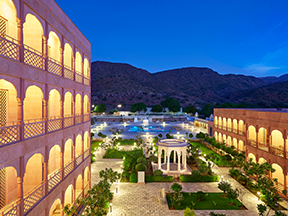Sacred Exploration: Pushkar's Temples and Festivals Near Pratap Mahal, Ajmer

Introduction
Nestled in the heart of Rajasthan, Pushkar is a timeless town that epitomizes spirituality and devotion. Known as one of the most sacred destinations in India, Pushkar boasts an array of stunning temples and vibrant festivals that draw pilgrims and travelers alike. Surrounded by the serene Aravalli Hills, this holy town is also home to the sacred Pushkar Lake, believed to have been created by Lord Brahma himself.
Staying at Pratap Mahal,v Ajmer, offers visitors an unparalleled opportunity to explore Pushkar’s divine essence while enjoying world-class hospitality.
Historical Background
Mythological Origins
Pushkar’s significance is deeply rooted in Hindu mythology. According to legend, Lord Brahma, the creator of the universe, dropped a lotus flower, which resulted in the formation of the sacred Pushkar Lake. Temples and rituals around this lake have made the town a prominent pilgrimage site, often referred to as Tirtha-Raj, the king of pilgrimage sites.
Historical Significance
The temples of Pushkar have stood the test of time, reflecting the rich cultural tapestry of the region. Many were constructed during the Gupta, Mughal, and Rajput eras, showcasing the influence of diverse rulers. Despite historical challenges, such as invasions, these temples remain enduring symbols of faith and artistry.
Top 10 Temples in Pushkar
1. Brahma Temple
The only temple in the world dedicated to Lord Brahma, this 14th-century structure is a spiritual and architectural marvel.
2. Gayatri Temple
Situated on a hilltop, this temple honors Gayatri, Brahma’s consort, offering breathtaking views of the town below.
3. Varaha Temple
Dedicated to Lord Vishnu’s Varaha (boar) incarnation, this temple boasts intricate carvings and ancient inscriptions.
4. Raghunath Temple
A vibrant shrine dedicated to Lord Rama, it features striking images of Hindu deities and is known for its peaceful ambiance.
5. Apteshwar Temple
A subterranean temple devoted to Lord Shiva, it is renowned for its mystical aura and historical charm.
6. Old Rangji Temple
A unique blend of Mughal and Rajput architecture, this temple is dedicated to Lord Rangji, an incarnation of Vishnu.
7. Saraswati Temple
Celebrating the goddess of knowledge and arts, Saraswati Temple is a serene spot for contemplation.
8. Mahadeva Temple
Known for its marble sculptures and ornate domes, this temple is a popular site for Shiva devotees.
9. Sri Rama Vaikunth Temple
A relatively modern temple, it stands out with its intricate white marble architecture.
10. ManMahal
Though not a temple in the traditional sense, this heritage building is a must-visit for its regal aesthetics and lakefront views.
Architectural Styles of Pushkar Temples
Fusion of Styles
Pushkar’s temples embody a fusion of Rajput, Mughal, and South Indian architectural elements, a testament to the diverse cultural influences over centuries. From towering spires (shikharas) to intricate gopurams, the temples showcase unmatched craftsmanship.
Unique Features
Key features include:
- ● Intricate carvings depicting mythological scenes.
- ● Marble sculptures that reflect the grandeur of Hindu art.
- ● Domes and pillared halls, combining functionality and beauty.
These architectural marvels are not just places of worship but also repositories of artistic heritage.
Religious Significance and Festivals
Pilgrimage Destination
Pushkar is an essential destination for Hindu devotees. The sacred Pushkar Lake, surrounded by 52 bathing ghats, is believed to cleanse sins and grant salvation. Pilgrims flock to these ghats during auspicious occasions for rituals and prayers.
Festivals and Rituals
Pushkar is synonymous with vibrant festivals, the most notable being:
- ● Pushkar Camel Fair: A world-renowned event blending cultural celebrations with livestock trading.
- ● Kartik Purnima: During this time, thousands gather to take a holy dip in the lake, accompanied by chants and temple rituals.
Experiencing the Temples
Best Time to Visit
The ideal time to visit Pushkar is from October to March, coinciding with pleasant weather and major festivals like Kartik Purnima and the Pushkar Camel Fair.
How to Reach
- ● By Air: The nearest airport is in Jaipur, about 150 km away.
- ● By Rail: Pushkar is accessible via Ajmer Junction, which is well-connected to major Indian cities.
- ● By Road: Regular buses and taxis ply between Ajmer and Pushkar, making travel convenient.
Tips for Visitors
- ● Dress Modestly: Respect the sanctity of the temples by wearing traditional or conservative clothing.
- ● Follow Etiquette: Remove shoes before entering temples and maintain a respectful demeanor.
- ● Photography Guidelines: While photography is allowed in some areas, it’s best to confirm beforehand to avoid disruption.
For an enriching and luxurious experience, consider staying at Pratap Mahal, Ajmer. Explore exclusive offers at Soulful Abodes to enhance your spiritual journey.
CONCLUSION
Pushkar’s temples are not merely architectural structures but profound expressions of devotion, culture, and history. From the unique Brahma Temple to the mystical Apteshwar Temple, each shrine offers a spiritual and aesthetic experience like no other. Combined with vibrant festivals and rituals, Pushkar provides an immersive journey into India’s rich religious heritage.
Staying at Pratap Mahal, Ajmer, ensures comfort and proximity to this divine town. Embark on a journey to Pushkar and witness the timeless allure of its temples and traditions. Your sacred exploration awaits!